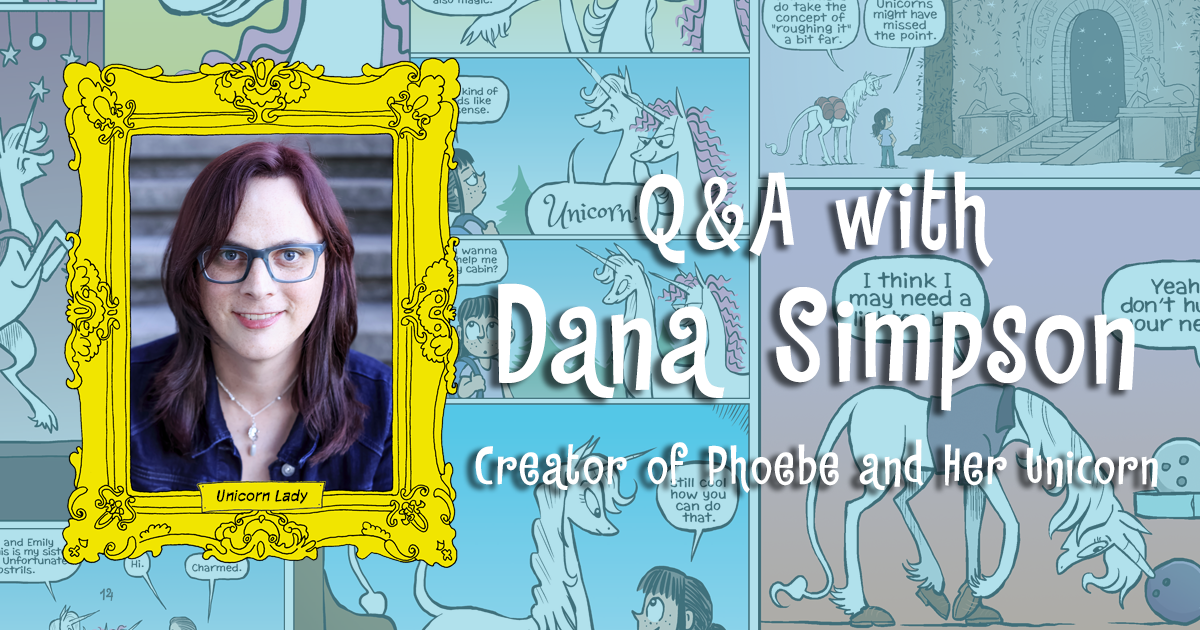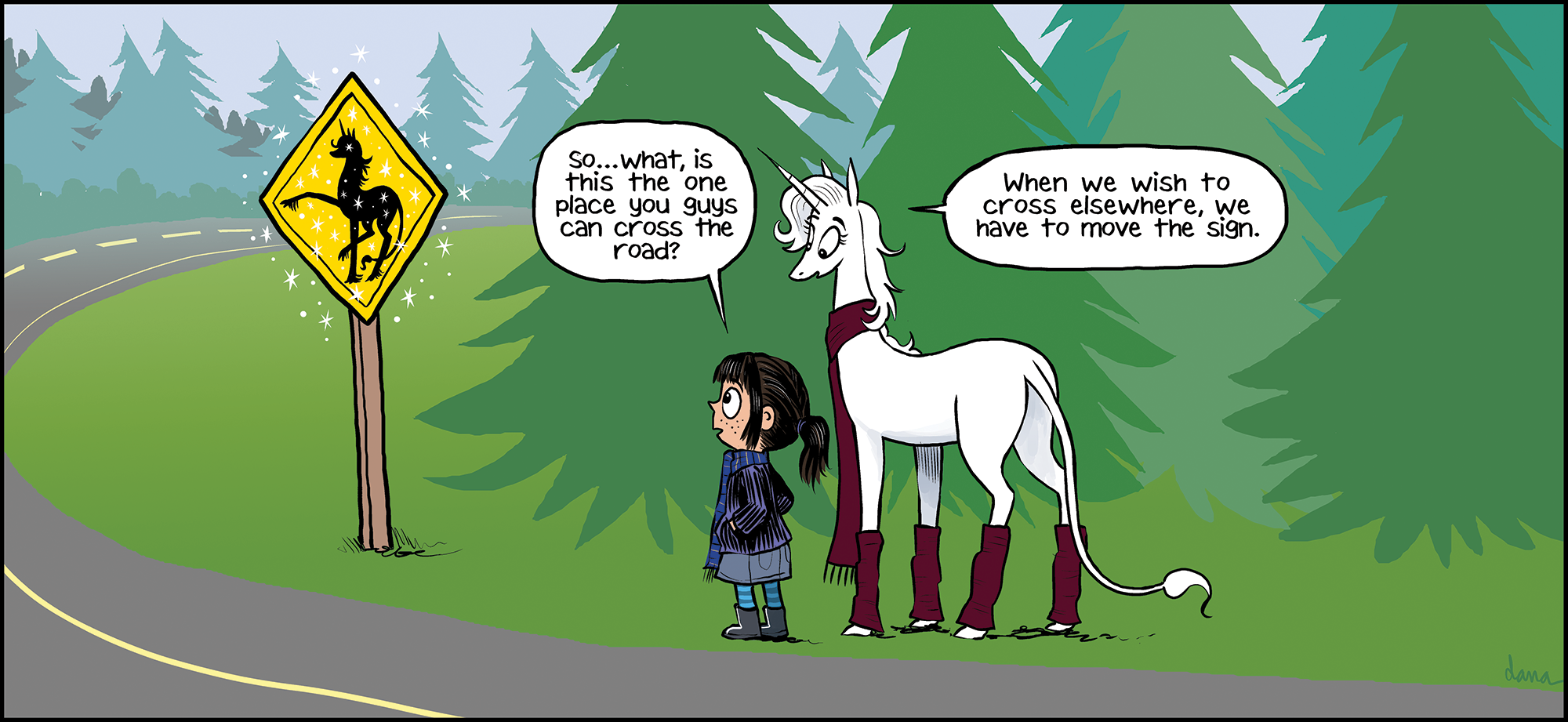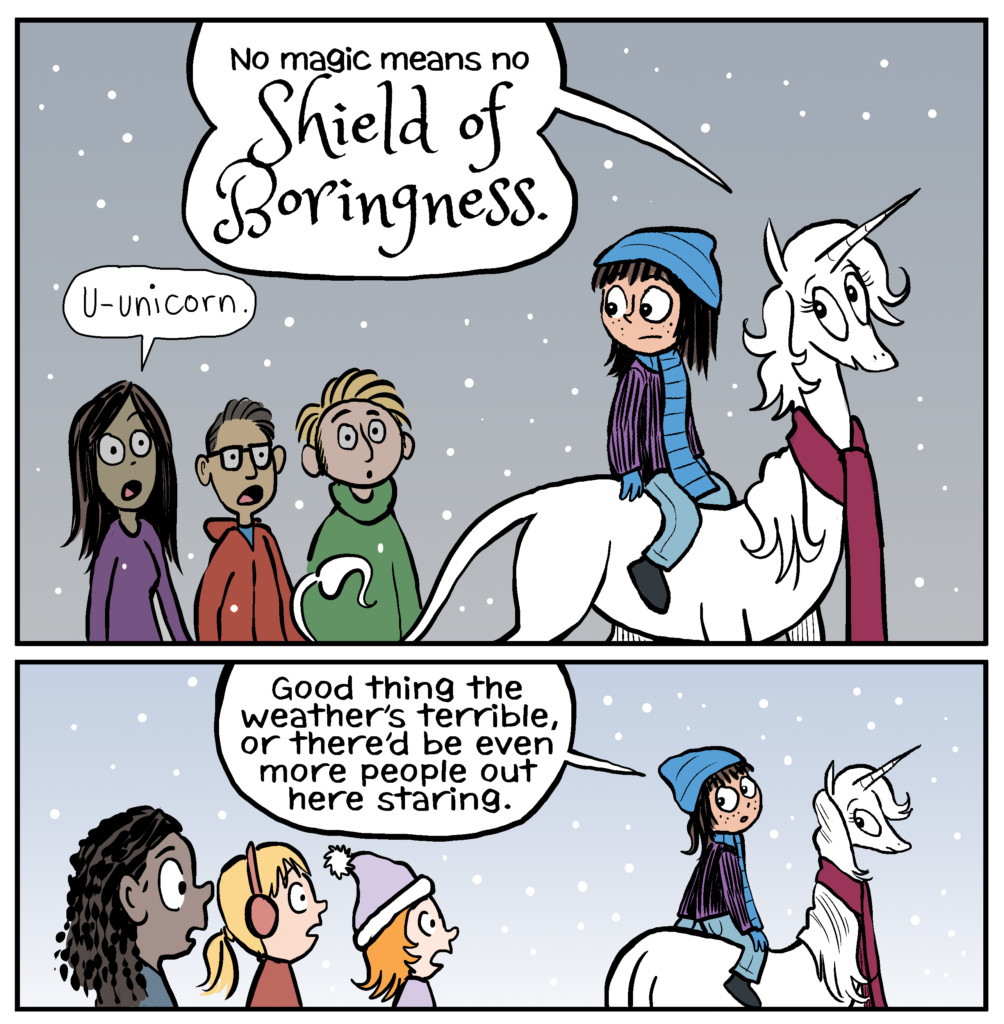
This interview was originally conducted and published October 2017.
Phoebe and Marigold never slow down, and neither does their author! 2017 was a magical year for creator Dana Simpson, with a fifth collection of Phoebe and Her Unicorn comics coming out in March and her first full-length graphic novel in the fall. Lucky for us, we caught up with Dana long enough to talk unicorns, friendship, and how kids have found a friend in Phoebe.
AMP: How did you get started writing books for middle graders? Is it something you’ve always wanted to do?
Dana Simpson: What I always wanted to do, since I was a kid, is write and draw comic strips.
Graphic novels weren’t as much of a thing, back then. What we did have were collections of comic strips. I had all the Calvin and Hobbes books, as did many kids. Garfield, The Far Side, Bloom County… I loved reading those. And I thought, “Wow, someone gets to have that as a job. Why not me? I can draw. Maybe I can also figure out how to write.”
So when I was a teenager, I started drawing comic strips. The internet was still a pretty new thing then. So the idea of being a web cartoonist was still pretty new. I came up with a strip based on some characters I’d drawn in class while I was supposed to be taking notes, and that became Ozy and Millie, a web comic I ended up drawing for the next ten years.
I spent years trying to move beyond the internet, and get the comic syndicated into newspapers, but it never worked out. And I was ready to move on, and I was thinking about trying to become a children’s book illustrator instead, and then someone told me about the Comic Strip Superstar contest. Which was a sort of cartoonist talent search, and the winner got to develop a strip for newspaper syndication, and also got a book contract.
And I thought, “Okay, I have as good a chance of winning this as anybody does.”
And I won. And I developed this comic strip about a little girl who’s best friends with a unicorn. And when the book came out, they told me they were going to release it as a middle-grade graphic novel, and I was like, “Okay, cool.”
I try to write comics I would want to read, so I suppose my natural sensibility is very middle-grade.
I really like that, because kids make the best fans. When they like stuff, they just LIKE it. It’s very sincere.
AMP: Kids love, love, love Phoebe and Her Unicorn. Why do you think kids are so drawn to it?
DS: Well, unicorns aren’t exactly a hard sell. Who doesn’t love unicorns? Who wouldn’t like having one as a best friend?
I kind of think the real key is Phoebe, though. She’s pretty much a self-portrait—I always say she’s me if you put me back in fourth grade and let me ride a unicorn to school. So she says and does the stuff I can imagine myself saying and doing, and I think that’s the key to writing a relatable character: the more personal a character is, the more universal and relatable they are.
I try to make Phoebe’s life relatable. She likes things kids like (unicorns, video games, cartoons), and deals with things kids deal with (school social hierarchies, homework, internet weirdness). Some of that is from my own childhood and some of it is from my life now. I’m glad kids connect with her.
A friend once told me, “You’ve given kids a weird friend in the comics to hang out with.” I’m proud of Phoebe.
AMP: Is there a message or theme you hope kids will take away from Phoebe and Her Unicorn?
DS: I guess there are a few! It’s okay to be different; the weird stuff about you might just be the coolest stuff. It’s worth trying to understand people who seem different from you. There are unicorns and magic everywhere if you look for them.
AMP: Your latest book, Phoebe and Her Unicorn in the Magic Storm, is a full-length graphic novel (vs. the previous comic strip collections). Why did you decide to change it up? What was it like to write a graphic novel?
DS: I did it because they told me to!
I’m being glib, but it’s also kind of true. My publisher asked if I wanted to do a couple of proper graphic novels starring Phoebe and Marigold, and I really liked the idea. The comic strip format is such that the stories can never be all that long, and so I had some longer story ideas I hadn’t been able to use. It was fun actually getting to tell one. You can tell a more complicated story when you don’t necessarily need to be funny every fourth panel, and when things don’t need to wrap up so quickly. You can develop characters more. Characters can have different kinds of conversations with each other. The stakes can be higher.
I think I know my characters better after having written Magic Storm. I really hope people like the result.
AMP: I’ve heard people express the idea that Phoebe “is for girls” and that boys won’t/don’t like it. Is that your experience? Do you see this when you visit schools or hear from fans?
DS: I’m aware of the idea. And I think there’s still some of that around, but I also think it’s much less widespread now than when I was growing up. I’ve met lots kids of both genders who are big fans, and generally the boys are pretty unashamed about it. And that’s as it should be.
I’m not writing specifically for girls. I’m writing a story in which the two main characters are female. Girls have always been allowed to identify with boy protagonists sometimes. I’m glad to see that works both ways for a lot of kids.
Thanks, Dana! For more, check out the Phoebe and Her Unicorn page!


